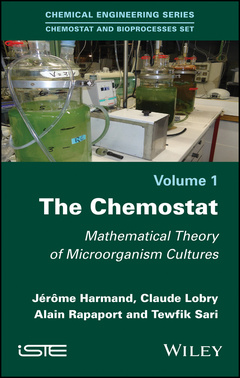The Chemostat Mathematical Theory of Microorganism Cultures
Auteurs : Harmand Jérôme, Lobry Claude, Rapaport Alain, Sari Tewfik

Invented by J. Monod, and independently by A. Novick and L. Szilard, in 1950, the chemostat is both a micro-organism culturing device and an abstracted ecosystem managed by a controlled nutrient flow.
This book studies mathematical models of single species growth as well as competition models of multiple species by integrating recent work in theoretical ecology and population dynamics. Through a modeling approach, the hypotheses and conclusions drawn from the main mathematical results are analyzed and interpreted from a critical perspective. A large emphasis is placed on numerical simulations of which prudent use is advocated.
The Chemostat is aimed at readers possessing degree-level mathematical knowledge and includes a detailed appendix of differential equations relating to specific notions and results used throughout this book.
Introduction ix
Chapter 1 Bioreactors 1
1.1. Introduction 1
1.1.1. What is a bioreactor? 1
1.1.2. Classification of biological reactors 2
1.1.3. A brief reminder of microbiology 3
1.2. Modeling of biological reactions 4
1.2.1. Regarding the state variables of the model 4
1.2.2. Biological processes and reaction scheme 8
1.2.3. Chemostat equations 11
1.2.4. Biological kinetics 14
1.2.5. The benefits of the chemostat 16
1.3. Toward “a little more” realism 17
1.3.1. Extensions 17
1.3.2. pH and physicochemical equilibria 20
1.3.3. Spatialization 22
1.3.4. Recent developments 23
Chapter 2 The Growth of a Single Species 25
2.1. Mathematical properties of the “minimal model” 26
2.1.1. General properties 26
2.1.2. The function μ is monotonic and bounded 29
2.1.3. The function μ is not monotonic 35
2.1.4. Interpretations 38
2.2. Simulations 40
2.2.1. Simulations in the phase space 41
2.2.2. Transients 43
2.3. Some extensions of the minimal model 45
2.3.1. Presence of biomass in the feed 46
2.3.2. Different dilutions 49
2.3.3. Density-dependent growth rate and characteristic at equilibrium 52
2.3.4. Yield depending on the density of the substrate 58
2.4. Bibliographic notes 61
Chapter 3 Competitive Exclusion 63
3.1. The case of monotonic growth functions 64
3.1.1. Steady states 64
3.1.2. Possible steady-states 65
3.1.3. Local stability of washout steady-state 66
3.2. Competitive exclusion at steady-state 67
3.2.1. Statement 68
3.2.2. Species at steady-state according to the dilution rate 68
3.2.3. Dynamics of proportions between species 69
3.2.4. Conclusion 73
3.3. Global stability 73
3.3.1. A “graphical” proof for two species 75
3.3.2. A proof for the general case 76
3.4. The case of non-monotonic growth functions 80
3.4.1. Growth set 81
3.4.2. Study of steady-states 82
3.4.3. Competitive exclusion 82
3.4.4. Competition between two species 83
3.4.5. Illustration and effect of a “bio-augmentation” 84
3.5. Bibliographic notes 88
Chapter 4 Competition: the Density-Dependent Model 93
4.1. Chapter orientation 93
4.2. Two-species competition 96
4.2.1. Behavior of an isolated species 97
4.2.2. Steady-state of two species in interaction 98
4.2.3. Steady-state stability 102
4.2.4. Simulations 103
4.3. N-species competition: exclusive intraspecific competition 104
4.3.1. Characteristic at equilibrium and coexistence 106
4.3.2. Simulations 110
4.4. N-species competition: the general case 111
4.4.1. A particular density-dependent model 112
4.4.2. Exclusive intraspecific competition 113
4.4.3. Dominant intraspecific competition 113
4.4.4. Undifferentiated competition 114
4.4.5. Dominant intraspecific competition 117
4.5. Bibliographic notes 123
Chapter 5 More Complex Models 125
5.1. Introduction 125
5.2. Models with aggregated biomass 126
5.2.1. Planktonic biomass versus aggregate biomass 127
5.2.2. Coexistence between the two forms 128
5.2.3. Coexistence steady-state 129
5.2.4. Stability study 133
5.2.5. The case of fast attachments/detachments 134
5.2.6. Consideration of several species 138
5.3. The “predator-prey” relationship in the chemostat 139
5.3.1. Introduction 139
5.3.2. The substrate-bacteria-predator “chain” 140
5.3.3. The substrate-bacteria-predators trophic network 143
5.3.4. Comparison to experimental data 146
5.4. Bibliographic notes 148
Appendices 151
Appendix 1 Differential Equations 153
Appendix 2 Indications for the Exercises 195
Bibliography 217
Index 225
Claude Lobry, University of Bordeaux and University of Nice, France.
Alain Rapaport, INRA, France.
Tewfik Sari, IRSTEA, France.
Date de parution : 08-2017
Ouvrage de 240 p.
16.3x23.6 cm
Thème de The Chemostat :
Mots-clés :
single species; growth; chemostat; ecosystem; culturing; abstracted; flow; nutrient; device; microorganism; controlled; single; models; multiple; integrating; book; mathematical; competition; studies; species; approach; main; critical; drawn


